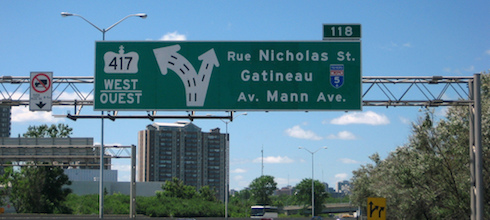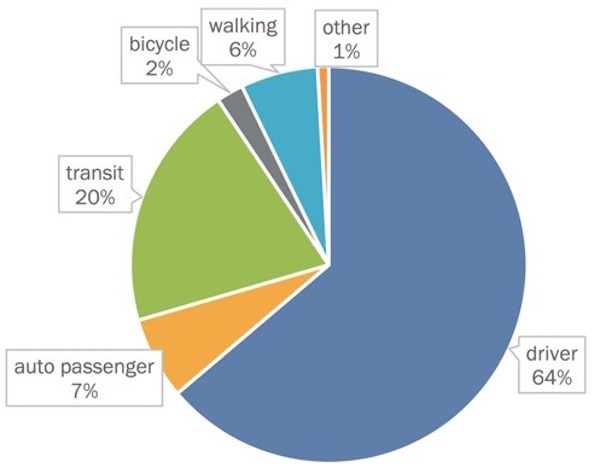
Paved Paradise: Could congestion pricing work in Ottawa?

Two weeks ago, the Healthy Transportation Coalition (HTC) held a forum at the University of Ottawa. The subject: congestion pricing in our nation’s capital. The HTC hosted six expert speakers for a lively debate (including our research team’s fearless leader, Dale Beugin). The same day, four Ottawa city councillors released a new report on congestion pricing in Ottawa, commissioned from Ottawa consultants CPCS.
Today, I consider these developments, drawing on our 2015 report on congestion pricing. Could congestion pricing work for Ottawa? If so, what form could it take?
Lay of the land
Congestion occurs because roads are free to use even though they are scarce, which incentivizes overuse. Putting a price on our roads changes drivers’ incentives and encourages them to switch to alternative modes of transport or travel at off-peak times. Adding new roads or widening existing ones isn’t a long-term solution. Without a price to signal scarcity, more drivers will crowd new roads, and the problem will persist.
As we noted in our report, smart congestion pricing should be customized to local context and geography. Like any city, Ottawa has its quirks. Several types of congestion pricing simply won’t work here, so picking and designing the right type is critical.
Canada’s congestion problem extends beyond its biggest cities. Small and medium-sized cities must contend with the economic and social costs of traffic too.
Ottawa doesn’t struggle with congestion the way Toronto or Vancouver do, but it struggles nonetheless. Despite its modest size (934,000 people), Ottawa sprawls out over 6,000 km of roads (about as many as Toronto). Most Ottawans a use car to commute, and the average trip is 28% longer when compared to free flow traffic. According to one estimate, Ottawa has a bigger traffic problem than Calgary, Edmonton, and Montreal.

Choose your lane
The CPCS report examines four policy options to reduce congestion and improve public transit use in Ottawa: tolls on highways 417 and 174, zone-based pricing in the downtown core, a $0.30/L increase in the gas tax, and a $2 parking levy downtown. The report touches on distance-travelled charges, but rules them out due to the technology barrier. Here’s a quick recap of the four options and CPCS’s analysis.
A $0.15/km toll on highways 417 and 174 would require provincial permission, and in fact the Ontario government has previously rejected a call to toll highway 174. Tolling highway 417 would reduce traffic and encourage commuters to hop on the parallel Confederation Line LRT (opening in 2018). It would also push other cars onto adjacent roads less able to handle the load. Without additional measures to address the response from drivers, this toll is likely too narrow to tackle Ottawa’s traffic problem. They would be effective on the 417 and 174, but may actually worsen the problem elsewhere.
A zone-based system, in the form of a $5 charge to enter downtown Ottawa during peak hours, would reduce congestion as effectively as tolls. The study finds that the number of kilometers driven in the core would fall by 250,000 per day by 2031—the greatest reduction of any option. But Ottawa’s core has a large number of access points, which would make implementation costly and administration cumbersome. Ottawa could expect to spend around $40 million per year and generate $60 million, which limits revenue recycling options. In short, technology costs need to fall for zone-based charges become financial viable in Ottawa.
Increasing the gas tax by $0.30/L wouldn’t affect when and where people drive, so it shouldn’t come as a surprise that this option results in the smallest reduction in kilometers driven (48,000 per year). Since the objective is reducing congestion, gas taxes don’t make a ton of sense. They cannot provide a signal to drivers to avoid downtown at certain times of the day, and, as we discussed previously, they have also become an increasingly ineffective revenue tool. The higher the tax, the less people drive; the less people drive, the less revenue is generated.
A $2 parking levy isn’t the most effective or comprehensive way to reduce congestion, but according to CPCS’s analysis, could reduce the daily number of kilometers driven downtown by 136,000 by 2031. This is a little more than half of what we could expect from tolls or zone-based charges. The true appeal of a parking levy lies in its simplicity. It’s the easiest tool to implement from both a technical and administrative perspective.
Given the cost and scope issues associated with other options, the report concludes that parking charges likely make the most sense for Ottawa, at least in the short-term. They offer the additional advantage of flexibility; depending on their design they can influence transportation choices across times, modes, and locations.
Hello San Francisco
Ottawa wouldn’t be the first city to use a downtown parking charge to tackle congestion. San Francisco successfully implemented a pilot parking program called SFpark in 2011. The target: parking occupancy of 60% to 80% in the pilot areas. In other words, allocating parking spots more efficiently while keeping 20% to 40% of spots available at all times.
SFpark proved an effective way to optimize parking availability. The target parking space occupancy rate increased by 31% in the trial areas compared with 6% in the control areas. The amount of time that city blocks were too full for drivers to find a parking space (90% to 100% occupancy) fell by 16% in pilot areas and grew by 51% in control areas.
SFpark also reduced congestion. Circling for parking—a serious contributor to downtown traffic— declined an estimated 50%. Vehicle miles travelled also decreased by 30% in the pilot areas compared with a 6% decrease in the control areas.

It’s time for Ottawa to get creative
Ottawa’s congestion problem will grow with the city. It isn’t going to go away anytime soon. We need to put new options on the table, and right now parking charges are a good fit. Right now, other options are too expensive, too complex, or worse yet, too narrow.
Implementing CPSC’s findings will reduce traffic and pollution, and make it easier to find parking downtown. Building more roads and widening the 417 will not put us on this path (or address the economic costs that come with congestion). With Ottawa’s new light rail transit system on the horizon, there’s never been a better time to start thinking about changing the incentives around driving.




Comments are closed.